Will the Sun clear the EPROM?
A long time ago in devices read-only data was stored in EPROMs. These types of memories were electrically programmed and erased with UV radiation. Erasing was possible thanks to a quartz window in the housing (there were also cheaper one-time programmable memories without a window in the housing).
EPROMs could be found on PC motherboards (BIOS), network cards (booting program), and automation and control devices (they stored the program executed by the microcontroller).
Most hobbyists had access to or had an EPROM programmer (eg Willem), but very rarely someone had an EPROM eraser. Erasers were equipped with UV-C light sources, tightly closed in an EPROM cassette (UVC is harmful to humans - especially the skin and eyes), better models had a simple timer system that turned off EPROM exposure.
How did hobbyists deal with EPROM erasing?
Usually they used the available UVC source, e.g. in the form of a mercury lamp, UV-C germicidal fluorescent lamp or the so-called quartz watches. With a little practice and caution, this "free" method managed to erase the EPROM content. Reading the topics Erasing EPROM memory with UV eyelet and Homemade EPROM eraser you can find surprising suggestions for use pepper shakers and migomat , flash and the sun .
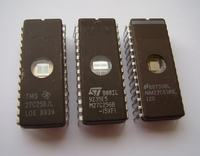
Will solar radiation erase EPROM?
In the last heat wave, I decided to check in practice how long it will take to erase EPROM with sunlight. In the 27C256 Microchip memory specification, I found information that the dose of 15Ws / cm2 should be applied and that a light source with a wavelength of 2537 angstroms (253.7nm UV-C) should be used, with an intensity of 12000uW, the irradiation should last 20 minutes. According to the specifications, the data storage capacity is > 200 years however, I have happened to run into automation devices where the EPROM content has degraded after ~ 20 years.
UVC radiation is quite well damped by the atmosphere and it is difficult to determine what time of exposure will be needed. According to Wikipedia The sun can erase the EPROM in a week, while a fluorescent lamp (the usual one shining with visible light) in three years. Not without reason on EPROMsprinted paper or aluminum stickers were placed, which, apart from the informative function, blocked the access of UV light that degraded the memory content.
For the experiment, EPROMs of unknown origin were obtained, looking at the content of one of the dice, you can see that it came from a device with some language settings.

The 27C256 memory was placed on the roof of the building for two weeks. The memory has a capacity of 32KB, which is exactly 32,768 bytes, which gives 262144 bits, ? 262144 = 512, i.e. we can visualize the memory content as a 512x512 pixel image. Bits 0 are marked as a blue pixel, bits 1 as a red pixel, and bits deleted by the sun (0-> 1) as yellow pixels. Below is the "appearance" of the memory before exposure to sunlight and after two weeks of exposure.
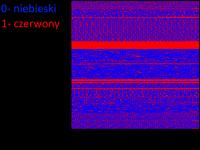
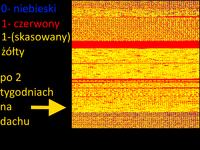
You can see that most of the memory has been deleted, so the method works, however, is quite unpredictable and depends on the current weather. I had a few more EPROMs, I wonder how the memory erasing goes over time. The EPROM was placed on the eastern wall of the building, while the content was read periodically using Arduino Mini and saved on the SD card. A simple code and two '4040 counters made it possible to address all 27C256 memory cells and save the content in 512 byte blocks to subsequent files on the micro SD card. The system was powered by 5V, therefore a 3.3V level converter and stabilizer was used for the SD card.
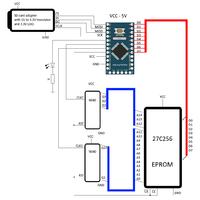
Code for Arduino that reads data from EPROM cyclically:
Subsequent dumps of EPROM contents were changed with a simple script in Python to PNG files with a resolution of 512x512 pixels showing the process of memory erasing by solar radiation. The script was run in Python 3.5 using the library to create PNG files PILLOW 3.3.0.
Python code for converting EPROM data to 512x512 pixel PNG files:
[syntax=python]
from PIL import Image
EPROM_SIZE=32768
SIZE_X=512
SIZE_Y=512
FILES=20
#base image
base_file=open("000", "rb")
chunk = base_file.read(EPROM_SIZE)
if chunk:
print("Base memory image saved form file 000.")
base_image = bytearray(chunk)
else:
print("Base memory image saving form file 000 err!")
base_file.close()
file_list=open("file_list.txt", "w")
err_list=open("err_list.txt", "w")
changes_list=open("changes_list.txt", "w")
#files processing
n=0
e=0
for f in range(0,FILES):
in_file=open('{:03d}'.format(f), "rb");
tmp=n
print("processing file: "+'{:03d}'.format(f))
chunk = in_file.read(EPROM_SIZE)
while chunk:
raw_image = bytearray(chunk)
imgSize = (SIZE_X,SIZE_Y)
img=Image.new('RGB', imgSize, color=0)
CH=0
ERR=0
for y in range(0,SIZE_Y-1):
for x in range(0, SIZE_X-1):
bit_val=(raw_image[((y*SIZE_X)+x)//8])&(1
EPROMs could be found on PC motherboards (BIOS), network cards (booting program), and automation and control devices (they stored the program executed by the microcontroller).
Most hobbyists had access to or had an EPROM programmer (eg Willem), but very rarely someone had an EPROM eraser. Erasers were equipped with UV-C light sources, tightly closed in an EPROM cassette (UVC is harmful to humans - especially the skin and eyes), better models had a simple timer system that turned off EPROM exposure.
How did hobbyists deal with EPROM erasing?
Usually they used the available UVC source, e.g. in the form of a mercury lamp, UV-C germicidal fluorescent lamp or the so-called quartz watches. With a little practice and caution, this "free" method managed to erase the EPROM content. Reading the topics Erasing EPROM memory with UV eyelet and Homemade EPROM eraser you can find surprising suggestions for use pepper shakers and migomat , flash and the sun .

Will solar radiation erase EPROM?
In the last heat wave, I decided to check in practice how long it will take to erase EPROM with sunlight. In the 27C256 Microchip memory specification, I found information that the dose of 15Ws / cm2 should be applied and that a light source with a wavelength of 2537 angstroms (253.7nm UV-C) should be used, with an intensity of 12000uW, the irradiation should last 20 minutes. According to the specifications, the data storage capacity is > 200 years however, I have happened to run into automation devices where the EPROM content has degraded after ~ 20 years.
UVC radiation is quite well damped by the atmosphere and it is difficult to determine what time of exposure will be needed. According to Wikipedia The sun can erase the EPROM in a week, while a fluorescent lamp (the usual one shining with visible light) in three years. Not without reason on EPROMsprinted paper or aluminum stickers were placed, which, apart from the informative function, blocked the access of UV light that degraded the memory content.
For the experiment, EPROMs of unknown origin were obtained, looking at the content of one of the dice, you can see that it came from a device with some language settings.

The 27C256 memory was placed on the roof of the building for two weeks. The memory has a capacity of 32KB, which is exactly 32,768 bytes, which gives 262144 bits, ? 262144 = 512, i.e. we can visualize the memory content as a 512x512 pixel image. Bits 0 are marked as a blue pixel, bits 1 as a red pixel, and bits deleted by the sun (0-> 1) as yellow pixels. Below is the "appearance" of the memory before exposure to sunlight and after two weeks of exposure.


You can see that most of the memory has been deleted, so the method works, however, is quite unpredictable and depends on the current weather. I had a few more EPROMs, I wonder how the memory erasing goes over time. The EPROM was placed on the eastern wall of the building, while the content was read periodically using Arduino Mini and saved on the SD card. A simple code and two '4040 counters made it possible to address all 27C256 memory cells and save the content in 512 byte blocks to subsequent files on the micro SD card. The system was powered by 5V, therefore a 3.3V level converter and stabilizer was used for the SD card.

Code for Arduino that reads data from EPROM cyclically:
Code: C / C++
Subsequent dumps of EPROM contents were changed with a simple script in Python to PNG files with a resolution of 512x512 pixels showing the process of memory erasing by solar radiation. The script was run in Python 3.5 using the library to create PNG files PILLOW 3.3.0.
Python code for converting EPROM data to 512x512 pixel PNG files:
[syntax=python]
from PIL import Image
EPROM_SIZE=32768
SIZE_X=512
SIZE_Y=512
FILES=20
#base image
base_file=open("000", "rb")
chunk = base_file.read(EPROM_SIZE)
if chunk:
print("Base memory image saved form file 000.")
base_image = bytearray(chunk)
else:
print("Base memory image saving form file 000 err!")
base_file.close()
file_list=open("file_list.txt", "w")
err_list=open("err_list.txt", "w")
changes_list=open("changes_list.txt", "w")
#files processing
n=0
e=0
for f in range(0,FILES):
in_file=open('{:03d}'.format(f), "rb");
tmp=n
print("processing file: "+'{:03d}'.format(f))
chunk = in_file.read(EPROM_SIZE)
while chunk:
raw_image = bytearray(chunk)
imgSize = (SIZE_X,SIZE_Y)
img=Image.new('RGB', imgSize, color=0)
CH=0
ERR=0
for y in range(0,SIZE_Y-1):
for x in range(0, SIZE_X-1):
bit_val=(raw_image[((y*SIZE_X)+x)//8])&(1



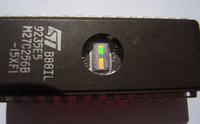
Comments
You asked a weird question at the end, because although hardware damage caused by changing the EPROM content does occur, it is usually difficult to pinpoint the cause. This is a long process (you noticed... [Read more]
That's right, it is usually difficult to establish the influence of some radiation as the cause of a failure. Hence my question, I am curious if someone went beyond the area of assumptions and managed... [Read more]
At the moment, it would probably be more useful to gain experience with the durability of writing common FLASH memories which are an extension of the EEPROM memory. Of course, they do not have a window... [Read more]
Great idea, I would like to read on elektroda.pl about the results of the test with EEPROM and FLASH memories that have been exposed to X-rays or some form of ionizing radiation that would reach the structure... [Read more]
You can try in the same way as with this EPROM. Put one FLASH cube written with a homogeneous matrix 010101 ... to solar exposure and not only - generally put "up to the sky" (as with a friend - on the... [Read more]
A few words from me: - firstly, the erase efficiency depends on the design of the memory cell (size, geometry, technology, etc.) - secondly, on the method of programming (the so-called fast algorithms... [Read more]
To the author on the linguistic issue. "Will the EPROM clear the sun?" In which language is this? It turns out that the Sun will be cleared by EPROM. Author, correct it, because it beats the e... [Read more]
@Sofeicz Nice setback, but not mine because as the author of this material I gave it a title "EPROM memory vs the sun" (which can be checked, for example, on FB elektroda.pl https://www.facebook.com/elektroda/).... [Read more]
Sorry for the light OT, but I remembered such a fact. In the 1980s I worked on a digital terminal program. The program was usually placed in EPROM dice. As it was problematic then to obtain components... [Read more]
I wonder what error in creating the structure caused such effects, i.e. either the inability to introduce / hold the charge for the gate, or the inability to remove the charge. Wrong type of material /... [Read more]
They can be watched on the net (USSR EPROM) And how much gold they can make for jewelry. [Read more]
Hehehe, I confirm, I have a few Soviet EPROMs and yes, they were very hard to delete (several hours of exposure), as for programming - it depends on how they were programmed - 2KiB ( ;) 573??2 - 2716 counterparts... [Read more]
Yes, yes. At the time, Eltra had a problem with the new product, it was about the turret just put into production. Massive information was poured into the service that the towers were behaving strangely... [Read more]
As if I have a lot of EPROMs with "eyelets". They come from printers (like probably the one from the tests). I can give some for rehearsals. They can be programmed, or I can delete them, because I have... [Read more]
Remember that not only UV destroys EPROM, because interference is definitely more important !!! This is a parallel rail. There have been failures many times before, when someone who did a great job did... [Read more]
Interesting article Link [Read more]
It looks like an urban legend and the mention of the Oder as a DSP-capable computer (radar signal) proves a very vivid imagination. I dare say that the F-117 also uses processors from the mid 80's... [Read more]
Interesting article indeed. I wonder how these pigs / fudges acted on people, since the radiation could from several meters and in a short time (train travel) have such a significant impact on the operation... [Read more]
The article is unbelievable - the author did not even want to illustrate it with a photo of the SM1800 machine, only the photo of the DWK-2 set was used ... there is nothing to write about the rest of... [Read more]